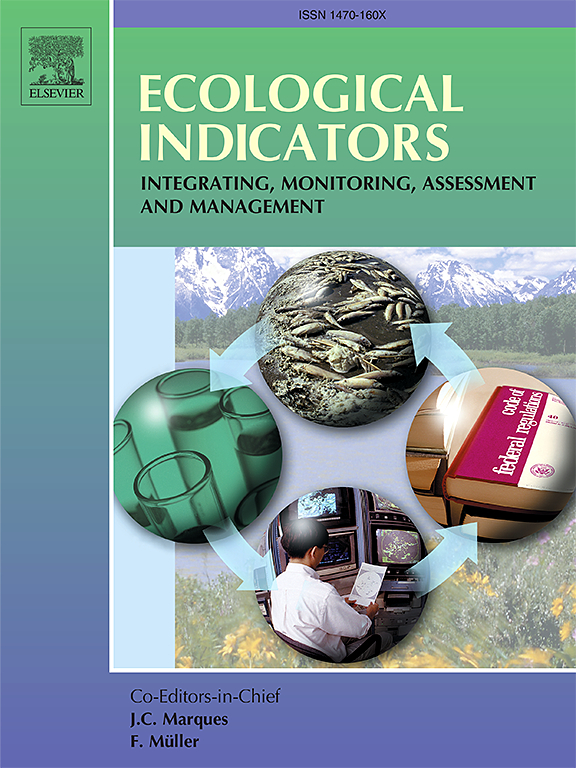A watershed fragility index for assessing the vulnerability of river ecosystems
IF 7
2区 环境科学与生态学
Q1 ENVIRONMENTAL SCIENCES
引用次数: 0
Abstract
Accelerating impacts of climate change have heightened the vulnerability of ecosystems, posing critical challenges to biodiversity conservation. While current climate change vulnerability assessment frameworks provide valuable insights, they often fall short of fully integrating local stressors. This paper introduces the Watershed Fragility Index (WFI), an innovative tool designed to address these gaps by offering a more comprehensive evaluation of multiple stressors. The WFI leverages Geographic Information Systems (GIS) for spatial analysis, Fuzzy logic for handling ecological complexity and variation, and the Analytic Hierarchy Process (AHP) for prioritizing stressors. For a better comprehension of various exposures, 12 factors are assessed − flooding susceptibility, temperature change, wildfire potential, soil type, geology, distance from waterbodies, slope, altitude, land use and cover, distance from roads, watercourse barriers, and forest change. They are organized into different sub-indexes related to natural disturbances, environmental fragility, and anthropogenic stressors. The tool is demonstrated on the Humber River watershed in the province of Newfoundland and Labrador, in eastern Canada. The results indicate that certain stressors create vulnerable areas near important lakes. Overall, the watershed is classified predominantly as low fragility. However, the most vulnerable regions, characterized by moderate fragility, are mainly found in the Lower Humber area, which also contains a larger area with roads, watercourse barriers, and steeper slopes. The outputs offer crucial insights to aid environmental planning within the Humber River watershed and can serve as an evaluation tool for other regions. The WFI is a novel tool for policy development, enabling environmental managers and conservationists to create targeted and adaptive strategies that enhance habitat and species resilience through comprehensive and integrated assessment.
评价河流生态系统脆弱性的流域脆弱性指数
气候变化的加速影响加剧了生态系统的脆弱性,对生物多样性保护提出了严峻挑战。虽然目前的气候变化脆弱性评估框架提供了有价值的见解,但它们往往不能充分整合当地的压力因素。本文介绍了流域脆弱性指数(WFI),这是一种创新工具,旨在通过对多种压力因素进行更全面的评估来解决这些差距。WFI利用地理信息系统(GIS)进行空间分析,模糊逻辑处理生态复杂性和变化,层次分析法(AHP)确定压力源的优先级。为了更好地理解各种风险,评估了12个因素:洪水易感性、温度变化、野火潜力、土壤类型、地质、与水体的距离、坡度、海拔、土地利用和覆盖、与道路的距离、水道屏障和森林变化。它们被组织成与自然干扰、环境脆弱性和人为压力因素相关的不同子指数。该工具在加拿大东部纽芬兰和拉布拉多省的亨伯河流域进行了演示。结果表明,某些压力源在重要湖泊附近造成了脆弱区域。总体而言,该流域主要被归类为低脆弱性。然而,最脆弱的地区,以中等脆弱性为特征,主要分布在Lower Humber地区,该地区也包含更大的道路,水道屏障和更陡峭的斜坡。这些产出为帮助亨伯河流域内的环境规划提供了重要的见解,并可作为其他地区的评价工具。WFI是政策制定的新工具,使环境管理者和保护主义者能够制定有针对性和适应性的战略,通过全面和综合的评估来增强栖息地和物种的恢复力。
本文章由计算机程序翻译,如有差异,请以英文原文为准。
求助全文
约1分钟内获得全文
求助全文
来源期刊

Ecological Indicators
环境科学-环境科学
CiteScore
11.80
自引率
8.70%
发文量
1163
审稿时长
78 days
期刊介绍:
The ultimate aim of Ecological Indicators is to integrate the monitoring and assessment of ecological and environmental indicators with management practices. The journal provides a forum for the discussion of the applied scientific development and review of traditional indicator approaches as well as for theoretical, modelling and quantitative applications such as index development. Research into the following areas will be published.
• All aspects of ecological and environmental indicators and indices.
• New indicators, and new approaches and methods for indicator development, testing and use.
• Development and modelling of indices, e.g. application of indicator suites across multiple scales and resources.
• Analysis and research of resource, system- and scale-specific indicators.
• Methods for integration of social and other valuation metrics for the production of scientifically rigorous and politically-relevant assessments using indicator-based monitoring and assessment programs.
• How research indicators can be transformed into direct application for management purposes.
• Broader assessment objectives and methods, e.g. biodiversity, biological integrity, and sustainability, through the use of indicators.
• Resource-specific indicators such as landscape, agroecosystems, forests, wetlands, etc.
 求助内容:
求助内容: 应助结果提醒方式:
应助结果提醒方式:


